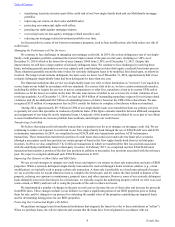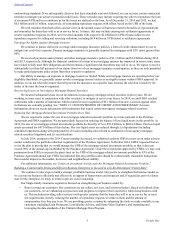Freddie Mac 2014 Annual Report Download - page 19
Download and view the complete annual report
Please find page 19 of the 2014 Freddie Mac annual report below. You can navigate through the pages in the report by either clicking on the pages listed below, or by using the keyword search tool below to find specific information within the annual report.-
 1
1 -
 2
2 -
 3
3 -
 4
4 -
 5
5 -
 6
6 -
 7
7 -
 8
8 -
 9
9 -
 10
10 -
 11
11 -
 12
12 -
 13
13 -
 14
14 -
 15
15 -
 16
16 -
 17
17 -
 18
18 -
 19
19 -
 20
20 -
 21
21 -
 22
22 -
 23
23 -
 24
24 -
 25
25 -
 26
26 -
 27
27 -
 28
28 -
 29
29 -
 30
30 -
 31
31 -
 32
32 -
 33
33 -
 34
34 -
 35
35 -
 36
36 -
 37
37 -
 38
38 -
 39
39 -
 40
40 -
 41
41 -
 42
42 -
 43
43 -
 44
44 -
 45
45 -
 46
46 -
 47
47 -
 48
48 -
 49
49 -
 50
50 -
 51
51 -
 52
52 -
 53
53 -
 54
54 -
 55
55 -
 56
56 -
 57
57 -
 58
58 -
 59
59 -
 60
60 -
 61
61 -
 62
62 -
 63
63 -
 64
64 -
 65
65 -
 66
66 -
 67
67 -
 68
68 -
 69
69 -
 70
70 -
 71
71 -
 72
72 -
 73
73 -
 74
74 -
 75
75 -
 76
76 -
 77
77 -
 78
78 -
 79
79 -
 80
80 -
 81
81 -
 82
82 -
 83
83 -
 84
84 -
 85
85 -
 86
86 -
 87
87 -
 88
88 -
 89
89 -
 90
90 -
 91
91 -
 92
92 -
 93
93 -
 94
94 -
 95
95 -
 96
96 -
 97
97 -
 98
98 -
 99
99 -
 100
100 -
 101
101 -
 102
102 -
 103
103 -
 104
104 -
 105
105 -
 106
106 -
 107
107 -
 108
108 -
 109
109 -
 110
110 -
 111
111 -
 112
112 -
 113
113 -
 114
114 -
 115
115 -
 116
116 -
 117
117 -
 118
118 -
 119
119 -
 120
120 -
 121
121 -
 122
122 -
 123
123 -
 124
124 -
 125
125 -
 126
126 -
 127
127 -
 128
128 -
 129
129 -
 130
130 -
 131
131 -
 132
132 -
 133
133 -
 134
134 -
 135
135 -
 136
136 -
 137
137 -
 138
138 -
 139
139 -
 140
140 -
 141
141 -
 142
142 -
 143
143 -
 144
144 -
 145
145 -
 146
146 -
 147
147 -
 148
148 -
 149
149 -
 150
150 -
 151
151 -
 152
152 -
 153
153 -
 154
154 -
 155
155 -
 156
156 -
 157
157 -
 158
158 -
 159
159 -
 160
160 -
 161
161 -
 162
162 -
 163
163 -
 164
164 -
 165
165 -
 166
166 -
 167
167 -
 168
168 -
 169
169 -
 170
170 -
 171
171 -
 172
172 -
 173
173 -
 174
174 -
 175
175 -
 176
176 -
 177
177 -
 178
178 -
 179
179 -
 180
180 -
 181
181 -
 182
182 -
 183
183 -
 184
184 -
 185
185 -
 186
186 -
 187
187 -
 188
188 -
 189
189 -
 190
190 -
 191
191 -
 192
192 -
 193
193 -
 194
194 -
 195
195 -
 196
196 -
 197
197 -
 198
198 -
 199
199 -
 200
200 -
 201
201 -
 202
202 -
 203
203 -
 204
204 -
 205
205 -
 206
206 -
 207
207 -
 208
208 -
 209
209 -
 210
210 -
 211
211 -
 212
212 -
 213
213 -
 214
214 -
 215
215 -
 216
216 -
 217
217 -
 218
218 -
 219
219 -
 220
220 -
 221
221 -
 222
222 -
 223
223 -
 224
224 -
 225
225 -
 226
226 -
 227
227 -
 228
228 -
 229
229 -
 230
230 -
 231
231 -
 232
232 -
 233
233 -
 234
234 -
 235
235 -
 236
236 -
 237
237 -
 238
238 -
 239
239 -
 240
240 -
 241
241 -
 242
242 -
 243
243 -
 244
244 -
 245
245 -
 246
246 -
 247
247 -
 248
248 -
 249
249 -
 250
250 -
 251
251 -
 252
252 -
 253
253 -
 254
254 -
 255
255 -
 256
256 -
 257
257 -
 258
258 -
 259
259 -
 260
260 -
 261
261 -
 262
262 -
 263
263 -
 264
264 -
 265
265 -
 266
266 -
 267
267 -
 268
268 -
 269
269 -
 270
270 -
 271
271 -
 272
272 -
 273
273 -
 274
274 -
 275
275 -
 276
276 -
 277
277 -
 278
278 -
 279
279 -
 280
280 -
 281
281 -
 282
282 -
 283
283 -
 284
284 -
 285
285 -
 286
286 -
 287
287 -
 288
288 -
 289
289 -
 290
290 -
 291
291 -
 292
292 -
 293
293 -
 294
294 -
 295
295 -
 296
296 -
 297
297 -
 298
298 -
 299
299 -
 300
300 -
 301
301 -
 302
302 -
 303
303 -
 304
304 -
 305
305 -
 306
306 -
 307
307 -
 308
308 -
 309
309 -
 310
310 -
 311
311 -
 312
312 -
 313
313 -
 314
314 -
 315
315 -
 316
316 -
 317
317 -
 318
318 -
 319
319 -
 320
320 -
 321
321 -
 322
322 -
 323
323 -
 324
324 -
 325
325 -
 326
326 -
 327
327 -
 328
328 -
 329
329 -
 330
330
 |
 |

14 Freddie Mac
exposure and liability on future sales of loans to us. It is possible that FHFA will require us to make further changes to the
framework.
We do not have our own mortgage loan servicing operation. Instead, our customers perform the primary servicing
function on our behalf. Our servicers are required to service loans in accordance with our standards. Under these standards, we
pay various incentives to servicers for completing workouts of problem loans. We also assess compensatory fees if servicers do
not achieve certain benchmarks with respect to servicing delinquent loans. Similar to seller violations, we can require servicers
to repurchase loans or provide alternative remedies in the case of servicing violations. For certain servicing violations, we
typically first issue a notice of defect and allow the servicer a period of time to correct the problem. If the servicing violation is
not corrected, we may issue a repurchase request. For breaches of servicing violations related to loans that have proceeded
through foreclosure and REO sale or other workouts (e.g., short sales), we will accept reimbursement for realized credit losses
in lieu of repurchase.
For more information, see “MD&A — RISK MANAGEMENT — Credit Risk Overview — Single-Family Mortgage
Credit Risk Framework and Profile,” “ — Institutional Credit Risk Profile — Single-Family Mortgage Seller/Servicers” and
“RISK FACTORS —Competitive and Market Risks — We face significant risks related to our delegated underwriting process
for single-family mortgages, including risks related to data accuracy and fraud. Recent changes to the process could increase
our risks.”
Credit Enhancements
Our charter requires that single-family mortgages with LTV ratios above 80% at the time of purchase be covered by
specified credit enhancements or participation interests. Primary mortgage insurance is the most prevalent type of credit
enhancement protecting our single-family credit guarantee portfolio, and is typically provided on a loan-level basis. Generally,
an insured loan must be in default and the borrower’s interest in the underlying property must have been extinguished, such as
through a short sale or foreclosure, before a claim can be filed under a primary mortgage insurance policy. The mortgage
insurer has a prescribed period of time within which to process a claim and make a determination as to its validity and amount.
For some mortgage loans, we transfer a portion of the credit risk to various third parties in STACR and ACIS transactions,
or other credit enhancements, including:
• lender recourse, where we may require a lender to repurchase a loan upon default;
• indemnification agreements, where we may require a lender to reimburse us for realized credit losses; and
• collateral pledged by lenders, and subordinated security structures.
Lender recourse and indemnification agreements are typically entered into contemporaneously with the purchase of a
mortgage loan as an alternative to requiring primary mortgage insurance or in exchange for a lower guarantee fee.
STACR and ACIS transactions are new types of credit risk transfer transactions we introduced in 2013. We have used
these risk transfer transactions to transfer a portion of credit losses that could occur under adverse home price scenarios
(through a mezzanine credit loss position) on certain groups of loans in our New single-family book from us to third-party
investors. In the STACR debt note transactions, we issue unsecured debt securities that reduce our exposure to credit risk, as
illustrated below:
Table of Contents
